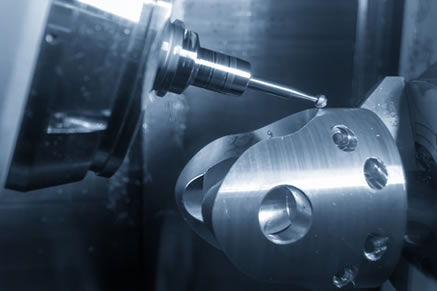
What is CNC Drill Bits?
This article covers the types of CNC drill bits you can find in CNC machinery. Computer controls and automation can greatly enhance certain manufacturing capabilities. Under computer numerical control (CNC) parameters, tasks that were formerly considered impractical can be accomplished quickly and with a high degree of precision. CNC programming can be designed to match multiple production needs, allowing an automated machine to specialize in a range of fabrication projects.
Despite the expanding role of computer controls, CNC-based production is still dependent on its machinery. This makes selecting the appropriate components and machine tools a priority regardless of the level of automation in a system. In the case of drilling machines, such as mills and routers, the type of drill bit used can be a significant influence on the final product. CNC programming can control the feed and depth rate in a drilling cycle, as well as the repetition of specific drilling operations, but choosing a well-suited drill bit remains the manufacturer’s decision.
Twist and Insert Drill Bit Design
The majority of industrial drill bits come in two general design categories: twist and insert. Insert drill bits are usually inexpensive and can be cheaply replaced when dull, eliminating the need for drill sharpening. They can also function without relying on a grind wheel. Insert drill bits are relatively easy to use and have a ground structural point that helps to center the drilling operation. However, insert bits can leave a burr at the hole’s exit, often necessitating post-drilling smoothing treatments. Also, if this drill bit breaks it can damage the tool holder, which may need to be replaced.
The twist drill design is a much more common alternative that constitutes the largest portion of drill bits manufactured in the United States. The twist drill bit features a winding, corkscrew flute pattern. The shape and sharpness of the flutes are central to the bit’s operation, and often require sharpening along a tool grinder. Additional worker training is sometimes needed to learn to handle a twist drill bit, but aside from grinder and sharpening costs, an individual twist bit is generally less expensive than most insert drill bits. In addition, this bit has a lower chance of producing burrs in an exit hole, reducing the need for time-consuming deburring treatments.
Drill Bits for CNC Metal Fabrication
There are a wide variety of drills used in metal fabrication that come in twist, insert, and other formats. Selecting a bit suitable for a given application depends on a number of factors, such as the type of metal being drilled, workpiece thickness, and the speed at which production needs to be accomplished. However, there are some specific categories of drill bits commonly used in CNC-based metalworking, including:
Indexable Bit: This type of insert drill bit is employed mostly in computer-controlled fabrication. It features ceramic inserts that serve as cutting edges for both the inner and outer spans of the cut, as well as a hardened cutting tip that reduces the need for re-sharpening. Indexable bits can drill rapidly and produce holes up to five times the diameter of the drill shaft.
Spade Drill Bit: The spade drill is a two-part device consisting of a metal body and a removable bit clamped into a precise slot. The spade bit is usually a twist format with special notches along the cutting edge designed to eliminate long chips that can clog the drilling area. In woodworking, a spade bit refers to a device used in handtooling rather than automated systems.
Ejector Bit: Ejector bits are used mostly in deep hole drilling operations and can be equipped with single or multiple cutting heads. The single head version has one cutting edge on the side that creates large radial holes. Multiple bits are used for producing even wider diameter holes and often have brazed carbide tips near the center line to improve cutting balance.
Woodworking CNC Drill Bits
The drills used for cutting wood usually have their own specifications that set them apart from metal fabrication varieties. They may require sharpening less frequently, and often need to apply less force to produce holes. These drill bits are commonly found in CNC lathes and milling machines, allowing high volume or repetitive woodworking operations to be carried out efficiently. Some of the common categories of wood drill bits include:
This bit features a flat cutting edge and a sharp center point or screw-like threads that can rapidly drill holes. Due to the risk of wandering when drilling thick materials, the flat bit is often coupled with a pumping device that blows away excess sawdust.
Dowel Bit: The dowel, or “lip and spur,” bit is a variation on the standard twist drill design. It has a sharp center point that increases its precision and two adjoining cutting spurs that help make fast, accurate holes. Like the indexable bit, dowel bits can be equipped with specialized inserts to further improve their cutting balance.
Augur Bit: These bits are also twist-based designs, but have a wide cutting edge and a single outer spur that cuts into the wood ahead of the edge. They also feature coiled threads that help channel sawdust away from the cutting point. Augur bits tend to drill more slowly than flat bits, but provide a higher degree of accuracy.
XTJ is a leading OEM Manufacturer that is dedicated to providing one-stop manufacturing solutions of Machining 6061 Aluminum from prototype to production. We are proud to be an ISO 9001 certified system quality management company and we are determined to create value in every customer relationship. We do that through collaboration, innovation, process improvements, and exceptional workmanship.lication: Automotive industry, Bicycle and motorcycle, Door and windows and furniture, Household appliance, Gas meter, Power tool,LED lighting, Medical instrument parts, ect.

